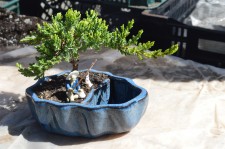Learn the Art of Bonsai From 9GreenBox.com - Producing Lavish Household Plants and Accessories Since 2007

Jurupa Valley, California, April 17, 2017 (Newswire.com) - The Art of Bonsai
“Bonsai” is the Japanese pronunciation of the Chinese word “penzai’, meaning “tray planting”. Bonsai are not a species but a general term for any plant tamed at a miniature size, in a vase or pot, and has been practiced for hundreds of years. People who keep bonsai favor the exercise for its meditative and calming effects. With years of training the trunk and leaves, the plant can be shaped into whatever the artist desires. Some bonsai live to be hundreds of years old, passed down through generations if they are properly maintained.
Bonsai are not typical houseplants. Juniper trees are evergreen coniferous shrubs that thrive best outside in humid environments.
Keeping a plant in a pot is vastly different from its natural state in the wild. For bonsai, plants are kept in small containers where their roots have very little space. These differences have a heavy impact on their ability to resist pests, transpiration, and nutrition, so proper long term care is necessary for a healthy life.
Training Methods
A variety of techniques are used to train bonsai from encouraging steady maturity, to molding shape and size. These methods vary considerably depending on your bonsai, or personal preference. These are only some general instructions, so we recommend further research such as books or online articles for further depth.
Pruning and Trimming – Cutting back the growth of branches, or parts of the trunk. This is what keeps the tree miniature. Leaves are typically removed by special scissors for bonsai, or any blade with a sharp edge. Do not trim the tree like a bush or a hedge, or the removal of the tips will weaken the tree and it will likely turn brown.
Clamping and Wiring – These instruments are for shaping the branches and trunk. By applying pressure on the plant, the direction of growth is encouraged to go a certain direction.
Grafting – Placing new growing material into the tree.
Aging – Deadwood bonsai techniques are used to enhance texture and maturity.
Watering bonsai depends on many factors, such as the time of year, dryness, and temperature, so a careful eye is needed in learning how to care for your plant’s needs. Juniper trees don’t like consistently moist soil, so they should be watered when the soil looks just about dry. That means you shouldn’t water again when the soil still appears wet. Don’t water on routine- observe the tree closely, and test the soil with your finger so see if it’s moist. You can use a watering can or hose with a gentle current, or mister. Run the water through until it drains out the bottom of the pot to make sure the root system gets a thorough soaking.
Sunlight
Juniper thrive best outside and should not remain inside for more than several days, as an indoor environment cannot provide necessary nutrition. Place the bonsai in an area sheltered from harsh wind and weather where they can receive full sunlight for at least six hours a day, year round. During winter if temperatures drop below twenty degrees, you should bring it to a sheltered place such as a garage or shed. When the tree is in dormancy it won’t require sunlight, but it will still need to be watered every two to three weeks. The leaves may temporarily turn brown, but they’ll turn green again in the spring.
Repotting
Repotting helps to establish a sturdier root ball, and will be necessary when the roots begin to crowd out of the draining holes. For evergreens, they need to be repotted every four to five years.
Proper health is greatly dependent on the quality of soil. A ratio of half akadama, a quarter pumice, and a quarter igneous rock is ideal. You can add compost to help retain more water if you don’t want to water often.
Gently remove the tree from the pot. Scrape away the dirt from the roots gently, and prune them back no more than a quarter of the root ball’s mass. Placing mesh over the draining holes keeps the soil from running out when watering. Then you can lay a fresh layer of soil at the bottom to elevate the tree to the desired height. Set the tree in gently and full the empty spaces with soil, making sure to not leave any gaps between the roots. Once the tree is settled, it needs a thorough soaking. Submerging the pot in a tub of water is a great way to hydrate the roots.
Since the root system of the bonsai is cramped in such a tiny space, the soil eventually runs out of nutrients to absorb, so fertilizing is necessary. You can use fish emulsion or a balanced fertilizer at half the dosage, feeding once every two weeks or at least twice a month. Do not fertilize during winter, as the plant will be in dormancy
Any question or suggesting , please email us : cs@9greenbox.com
Source: 9GreenBox